HSA 4740: Examining the Opioid Addiction Crisis - Literature Review
VerifiedAdded on 2023/05/29
|9
|1880
|220
Literature Review
AI Summary
This literature review delves into the opioid addiction crisis, highlighting its significant social, economic, and health-related problems. It examines the prevalence and incidence of nonmedical opioid consumption, linking it to increased mortality and morbidity rates. The review references studies that demonstrate the rise in opioid prescriptions and related emergency admissions, while also identifying gaps in research, such as the psychological impacts of opioid abuse, the role of healthcare professionals in prevention, and the effects of drug diversion. The review concludes by emphasizing the need for further research into nursing interventions to combat opioid addiction and improve patient outcomes. Desklib provides similar solved assignments and study resources.
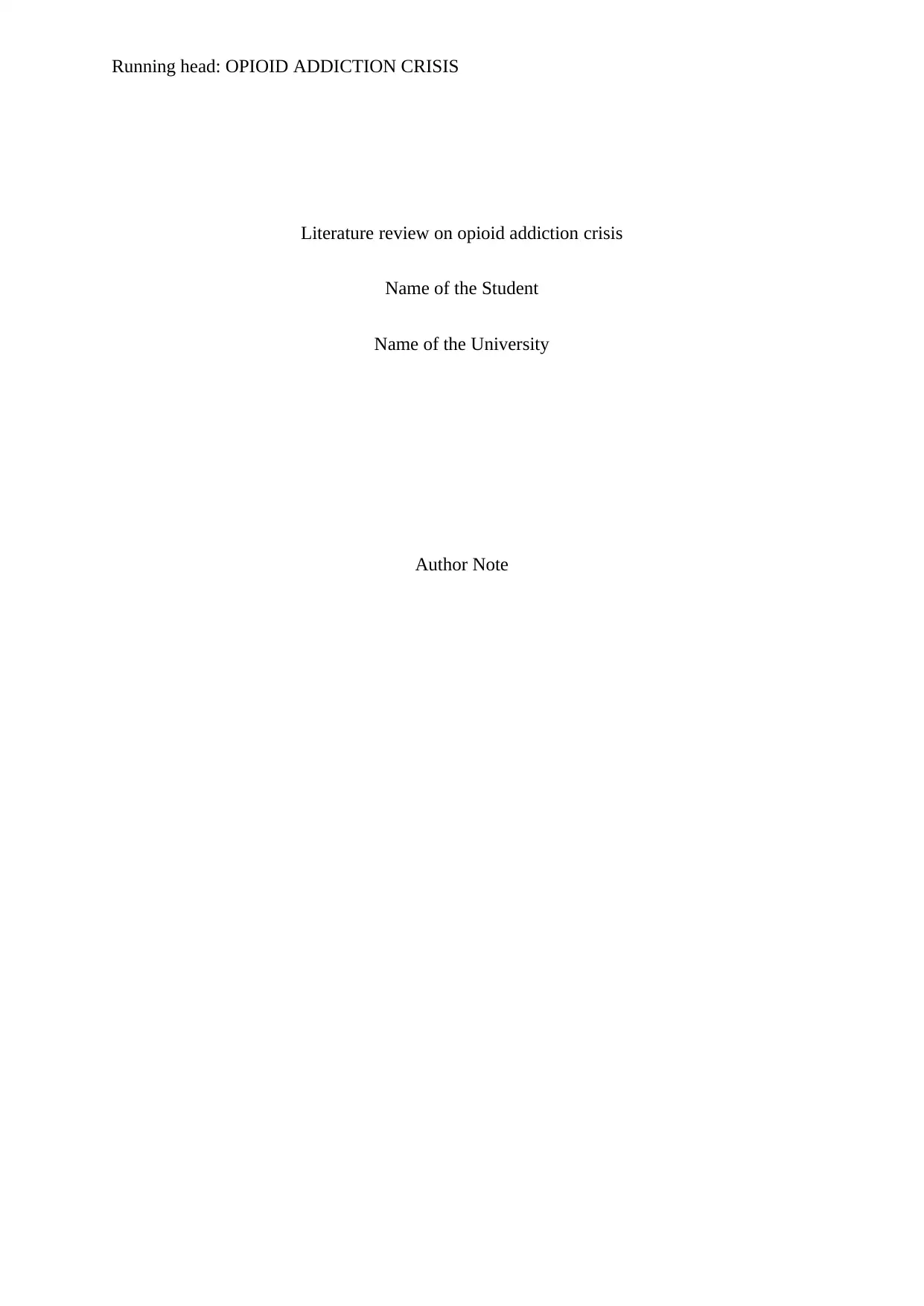
Running head: OPIOID ADDICTION CRISIS
Literature review on opioid addiction crisis
Name of the Student
Name of the University
Author Note
Literature review on opioid addiction crisis
Name of the Student
Name of the University
Author Note
Paraphrase This Document
Need a fresh take? Get an instant paraphrase of this document with our AI Paraphraser
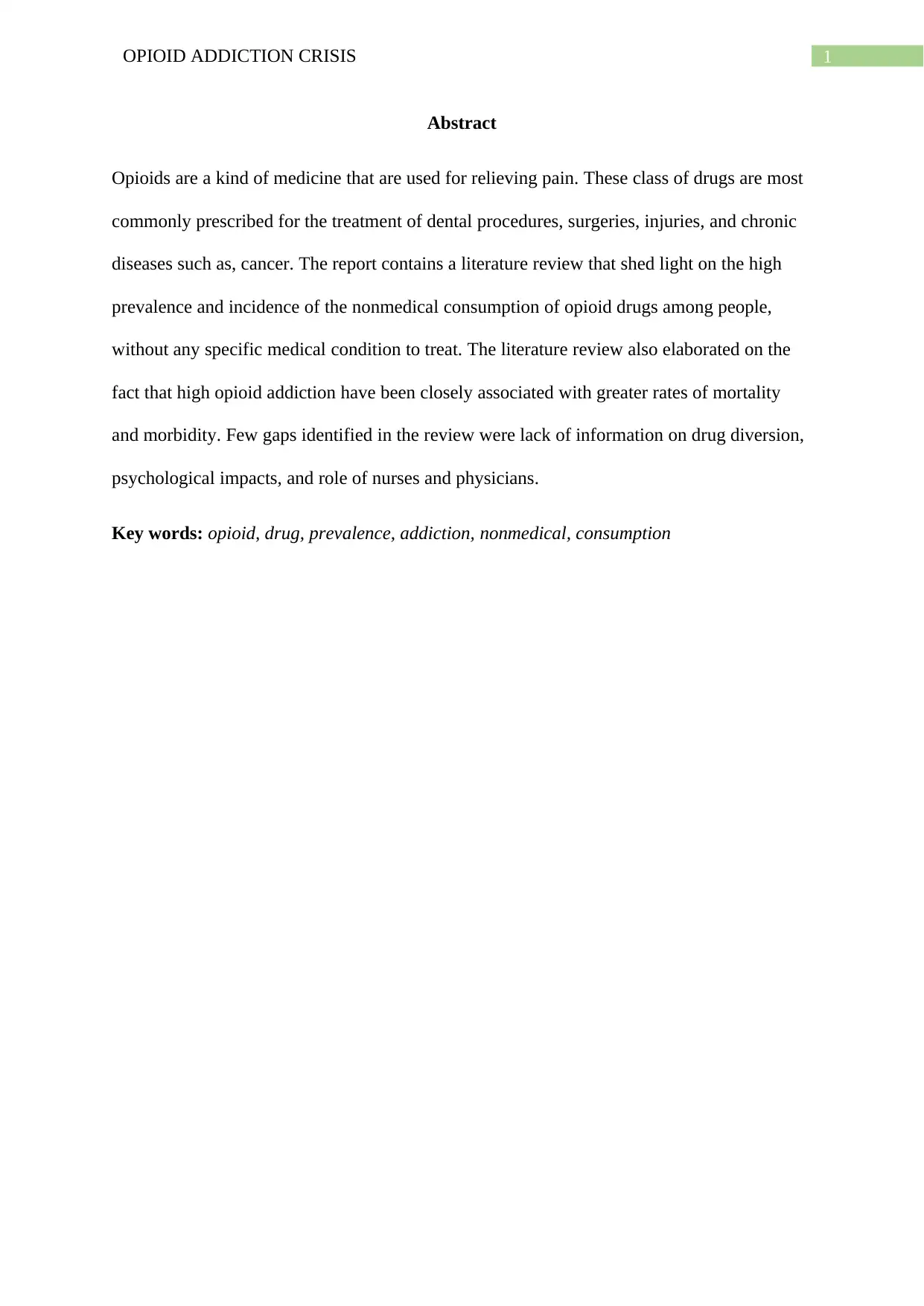
1OPIOID ADDICTION CRISIS
Abstract
Opioids are a kind of medicine that are used for relieving pain. These class of drugs are most
commonly prescribed for the treatment of dental procedures, surgeries, injuries, and chronic
diseases such as, cancer. The report contains a literature review that shed light on the high
prevalence and incidence of the nonmedical consumption of opioid drugs among people,
without any specific medical condition to treat. The literature review also elaborated on the
fact that high opioid addiction have been closely associated with greater rates of mortality
and morbidity. Few gaps identified in the review were lack of information on drug diversion,
psychological impacts, and role of nurses and physicians.
Key words: opioid, drug, prevalence, addiction, nonmedical, consumption
Abstract
Opioids are a kind of medicine that are used for relieving pain. These class of drugs are most
commonly prescribed for the treatment of dental procedures, surgeries, injuries, and chronic
diseases such as, cancer. The report contains a literature review that shed light on the high
prevalence and incidence of the nonmedical consumption of opioid drugs among people,
without any specific medical condition to treat. The literature review also elaborated on the
fact that high opioid addiction have been closely associated with greater rates of mortality
and morbidity. Few gaps identified in the review were lack of information on drug diversion,
psychological impacts, and role of nurses and physicians.
Key words: opioid, drug, prevalence, addiction, nonmedical, consumption
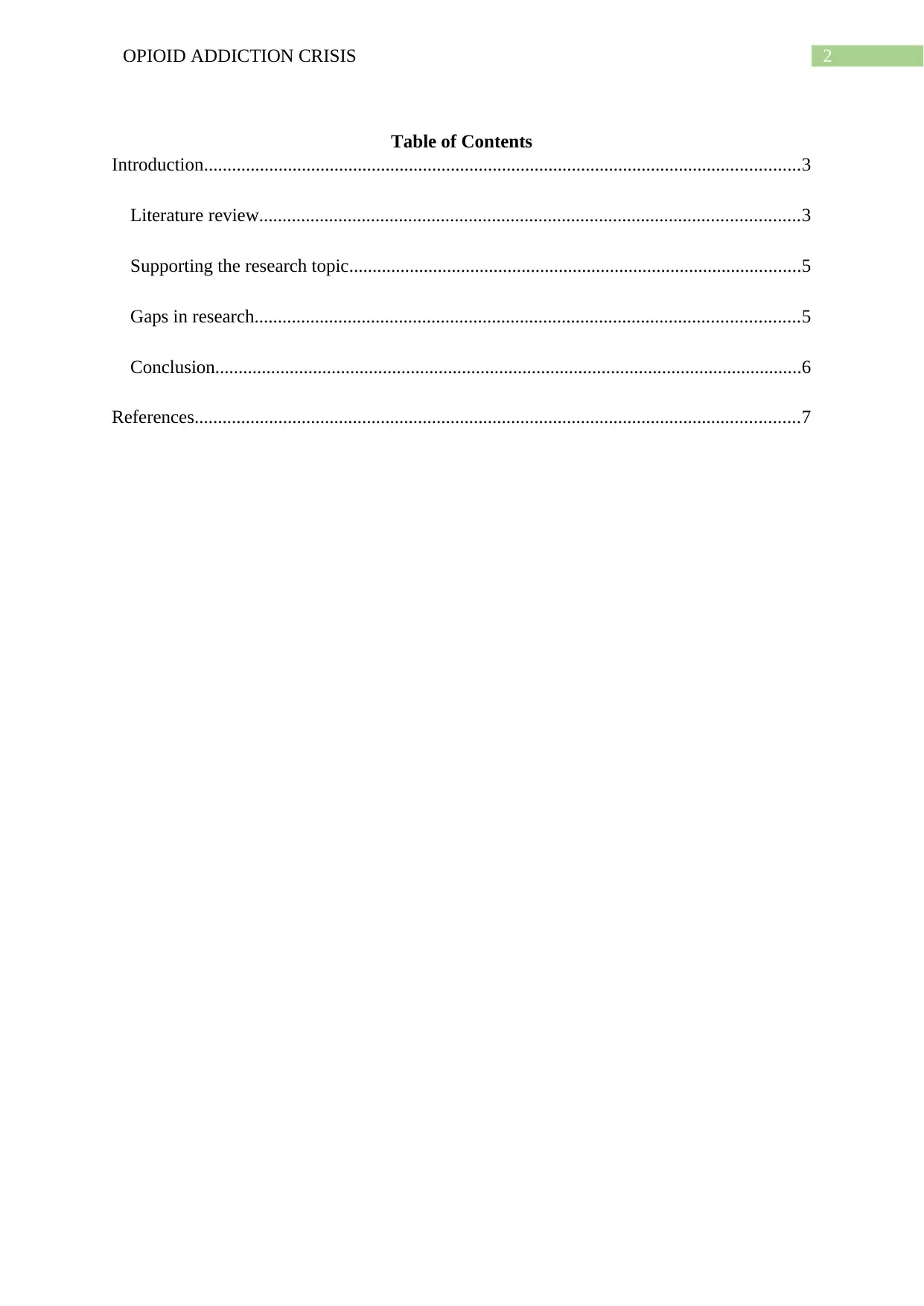
2OPIOID ADDICTION CRISIS
Table of Contents
Introduction................................................................................................................................3
Literature review....................................................................................................................3
Supporting the research topic.................................................................................................5
Gaps in research.....................................................................................................................5
Conclusion..............................................................................................................................6
References..................................................................................................................................7
Table of Contents
Introduction................................................................................................................................3
Literature review....................................................................................................................3
Supporting the research topic.................................................................................................5
Gaps in research.....................................................................................................................5
Conclusion..............................................................................................................................6
References..................................................................................................................................7
⊘ This is a preview!⊘
Do you want full access?
Subscribe today to unlock all pages.

Trusted by 1+ million students worldwide
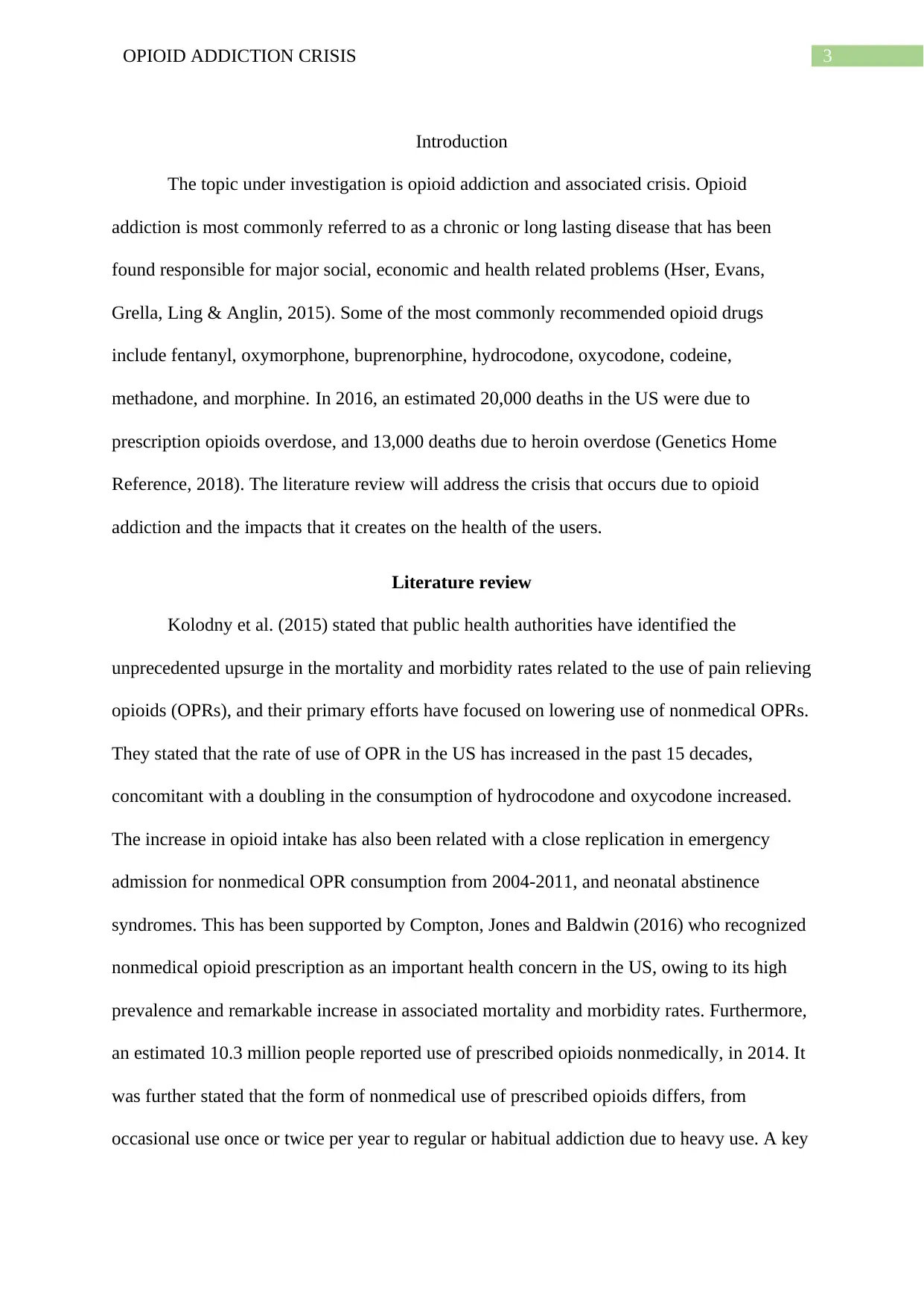
3OPIOID ADDICTION CRISIS
Introduction
The topic under investigation is opioid addiction and associated crisis. Opioid
addiction is most commonly referred to as a chronic or long lasting disease that has been
found responsible for major social, economic and health related problems (Hser, Evans,
Grella, Ling & Anglin, 2015). Some of the most commonly recommended opioid drugs
include fentanyl, oxymorphone, buprenorphine, hydrocodone, oxycodone, codeine,
methadone, and morphine. In 2016, an estimated 20,000 deaths in the US were due to
prescription opioids overdose, and 13,000 deaths due to heroin overdose (Genetics Home
Reference, 2018). The literature review will address the crisis that occurs due to opioid
addiction and the impacts that it creates on the health of the users.
Literature review
Kolodny et al. (2015) stated that public health authorities have identified the
unprecedented upsurge in the mortality and morbidity rates related to the use of pain relieving
opioids (OPRs), and their primary efforts have focused on lowering use of nonmedical OPRs.
They stated that the rate of use of OPR in the US has increased in the past 15 decades,
concomitant with a doubling in the consumption of hydrocodone and oxycodone increased.
The increase in opioid intake has also been related with a close replication in emergency
admission for nonmedical OPR consumption from 2004-2011, and neonatal abstinence
syndromes. This has been supported by Compton, Jones and Baldwin (2016) who recognized
nonmedical opioid prescription as an important health concern in the US, owing to its high
prevalence and remarkable increase in associated mortality and morbidity rates. Furthermore,
an estimated 10.3 million people reported use of prescribed opioids nonmedically, in 2014. It
was further stated that the form of nonmedical use of prescribed opioids differs, from
occasional use once or twice per year to regular or habitual addiction due to heavy use. A key
Introduction
The topic under investigation is opioid addiction and associated crisis. Opioid
addiction is most commonly referred to as a chronic or long lasting disease that has been
found responsible for major social, economic and health related problems (Hser, Evans,
Grella, Ling & Anglin, 2015). Some of the most commonly recommended opioid drugs
include fentanyl, oxymorphone, buprenorphine, hydrocodone, oxycodone, codeine,
methadone, and morphine. In 2016, an estimated 20,000 deaths in the US were due to
prescription opioids overdose, and 13,000 deaths due to heroin overdose (Genetics Home
Reference, 2018). The literature review will address the crisis that occurs due to opioid
addiction and the impacts that it creates on the health of the users.
Literature review
Kolodny et al. (2015) stated that public health authorities have identified the
unprecedented upsurge in the mortality and morbidity rates related to the use of pain relieving
opioids (OPRs), and their primary efforts have focused on lowering use of nonmedical OPRs.
They stated that the rate of use of OPR in the US has increased in the past 15 decades,
concomitant with a doubling in the consumption of hydrocodone and oxycodone increased.
The increase in opioid intake has also been related with a close replication in emergency
admission for nonmedical OPR consumption from 2004-2011, and neonatal abstinence
syndromes. This has been supported by Compton, Jones and Baldwin (2016) who recognized
nonmedical opioid prescription as an important health concern in the US, owing to its high
prevalence and remarkable increase in associated mortality and morbidity rates. Furthermore,
an estimated 10.3 million people reported use of prescribed opioids nonmedically, in 2014. It
was further stated that the form of nonmedical use of prescribed opioids differs, from
occasional use once or twice per year to regular or habitual addiction due to heavy use. A key
Paraphrase This Document
Need a fresh take? Get an instant paraphrase of this document with our AI Paraphraser
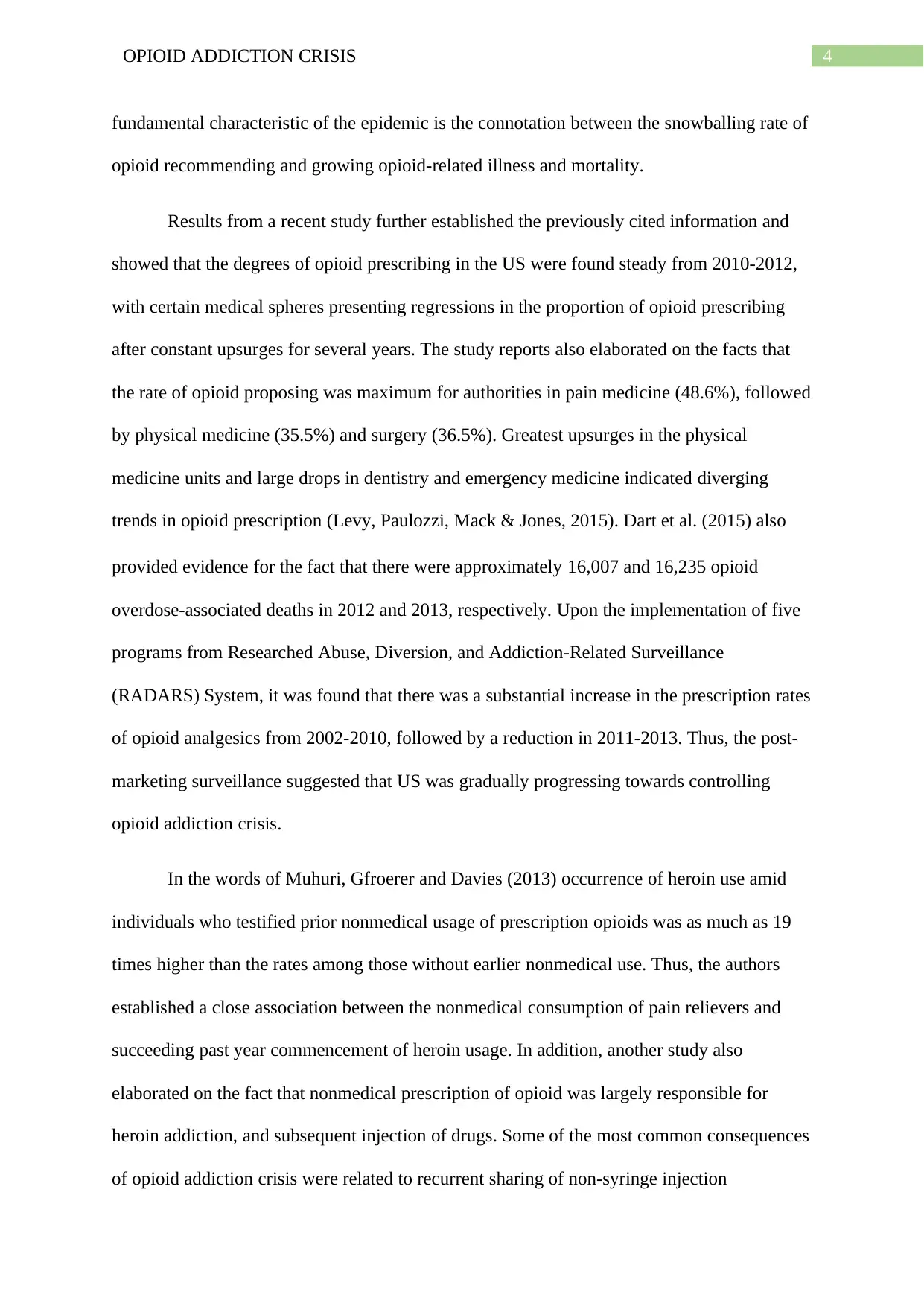
4OPIOID ADDICTION CRISIS
fundamental characteristic of the epidemic is the connotation between the snowballing rate of
opioid recommending and growing opioid-related illness and mortality.
Results from a recent study further established the previously cited information and
showed that the degrees of opioid prescribing in the US were found steady from 2010-2012,
with certain medical spheres presenting regressions in the proportion of opioid prescribing
after constant upsurges for several years. The study reports also elaborated on the facts that
the rate of opioid proposing was maximum for authorities in pain medicine (48.6%), followed
by physical medicine (35.5%) and surgery (36.5%). Greatest upsurges in the physical
medicine units and large drops in dentistry and emergency medicine indicated diverging
trends in opioid prescription (Levy, Paulozzi, Mack & Jones, 2015). Dart et al. (2015) also
provided evidence for the fact that there were approximately 16,007 and 16,235 opioid
overdose-associated deaths in 2012 and 2013, respectively. Upon the implementation of five
programs from Researched Abuse, Diversion, and Addiction-Related Surveillance
(RADARS) System, it was found that there was a substantial increase in the prescription rates
of opioid analgesics from 2002-2010, followed by a reduction in 2011-2013. Thus, the post-
marketing surveillance suggested that US was gradually progressing towards controlling
opioid addiction crisis.
In the words of Muhuri, Gfroerer and Davies (2013) occurrence of heroin use amid
individuals who testified prior nonmedical usage of prescription opioids was as much as 19
times higher than the rates among those without earlier nonmedical use. Thus, the authors
established a close association between the nonmedical consumption of pain relievers and
succeeding past year commencement of heroin usage. In addition, another study also
elaborated on the fact that nonmedical prescription of opioid was largely responsible for
heroin addiction, and subsequent injection of drugs. Some of the most common consequences
of opioid addiction crisis were related to recurrent sharing of non-syringe injection
fundamental characteristic of the epidemic is the connotation between the snowballing rate of
opioid recommending and growing opioid-related illness and mortality.
Results from a recent study further established the previously cited information and
showed that the degrees of opioid prescribing in the US were found steady from 2010-2012,
with certain medical spheres presenting regressions in the proportion of opioid prescribing
after constant upsurges for several years. The study reports also elaborated on the facts that
the rate of opioid proposing was maximum for authorities in pain medicine (48.6%), followed
by physical medicine (35.5%) and surgery (36.5%). Greatest upsurges in the physical
medicine units and large drops in dentistry and emergency medicine indicated diverging
trends in opioid prescription (Levy, Paulozzi, Mack & Jones, 2015). Dart et al. (2015) also
provided evidence for the fact that there were approximately 16,007 and 16,235 opioid
overdose-associated deaths in 2012 and 2013, respectively. Upon the implementation of five
programs from Researched Abuse, Diversion, and Addiction-Related Surveillance
(RADARS) System, it was found that there was a substantial increase in the prescription rates
of opioid analgesics from 2002-2010, followed by a reduction in 2011-2013. Thus, the post-
marketing surveillance suggested that US was gradually progressing towards controlling
opioid addiction crisis.
In the words of Muhuri, Gfroerer and Davies (2013) occurrence of heroin use amid
individuals who testified prior nonmedical usage of prescription opioids was as much as 19
times higher than the rates among those without earlier nonmedical use. Thus, the authors
established a close association between the nonmedical consumption of pain relievers and
succeeding past year commencement of heroin usage. In addition, another study also
elaborated on the fact that nonmedical prescription of opioid was largely responsible for
heroin addiction, and subsequent injection of drugs. Some of the most common consequences
of opioid addiction crisis were related to recurrent sharing of non-syringe injection
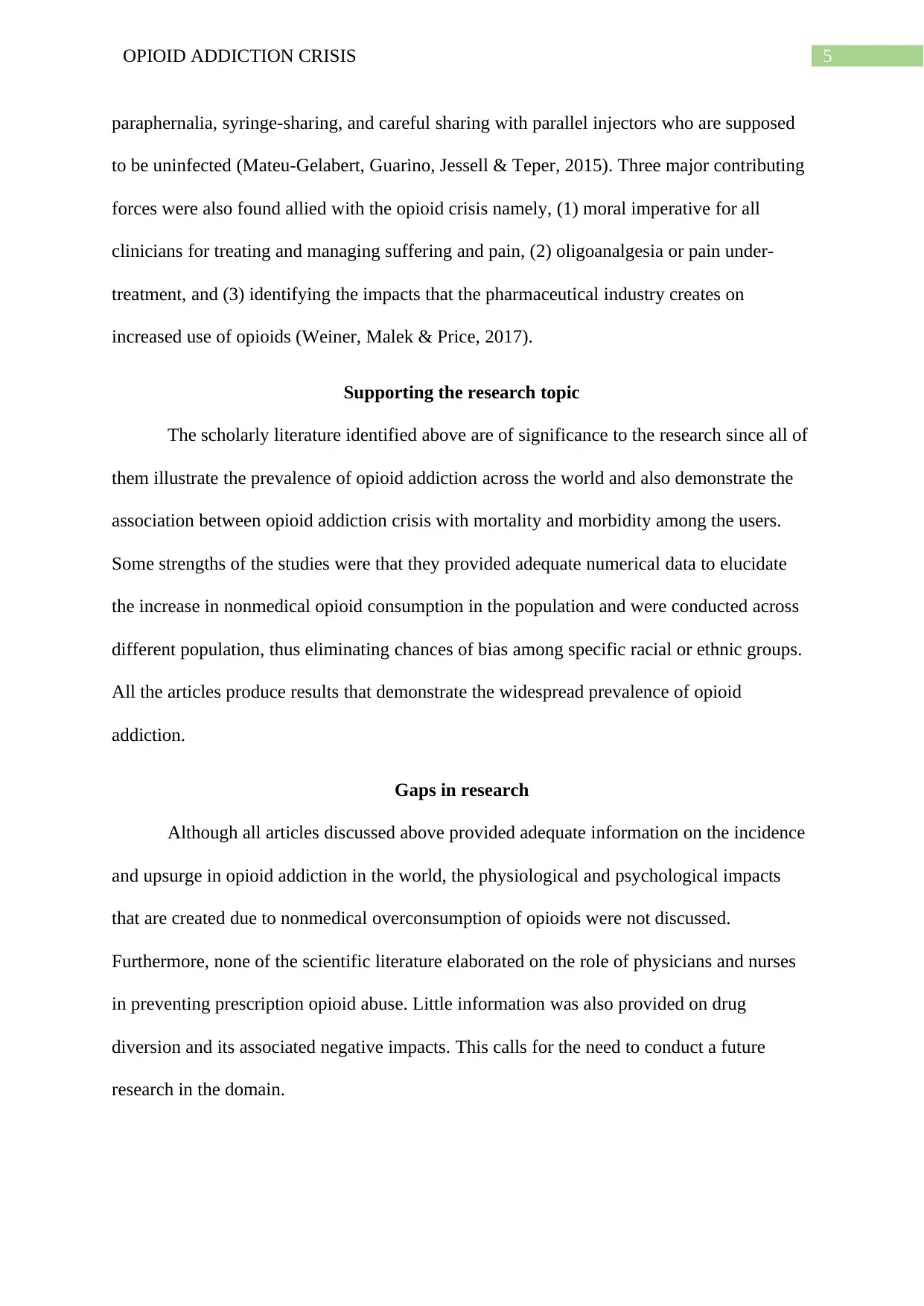
5OPIOID ADDICTION CRISIS
paraphernalia, syringe-sharing, and careful sharing with parallel injectors who are supposed
to be uninfected (Mateu-Gelabert, Guarino, Jessell & Teper, 2015). Three major contributing
forces were also found allied with the opioid crisis namely, (1) moral imperative for all
clinicians for treating and managing suffering and pain, (2) oligoanalgesia or pain under-
treatment, and (3) identifying the impacts that the pharmaceutical industry creates on
increased use of opioids (Weiner, Malek & Price, 2017).
Supporting the research topic
The scholarly literature identified above are of significance to the research since all of
them illustrate the prevalence of opioid addiction across the world and also demonstrate the
association between opioid addiction crisis with mortality and morbidity among the users.
Some strengths of the studies were that they provided adequate numerical data to elucidate
the increase in nonmedical opioid consumption in the population and were conducted across
different population, thus eliminating chances of bias among specific racial or ethnic groups.
All the articles produce results that demonstrate the widespread prevalence of opioid
addiction.
Gaps in research
Although all articles discussed above provided adequate information on the incidence
and upsurge in opioid addiction in the world, the physiological and psychological impacts
that are created due to nonmedical overconsumption of opioids were not discussed.
Furthermore, none of the scientific literature elaborated on the role of physicians and nurses
in preventing prescription opioid abuse. Little information was also provided on drug
diversion and its associated negative impacts. This calls for the need to conduct a future
research in the domain.
paraphernalia, syringe-sharing, and careful sharing with parallel injectors who are supposed
to be uninfected (Mateu-Gelabert, Guarino, Jessell & Teper, 2015). Three major contributing
forces were also found allied with the opioid crisis namely, (1) moral imperative for all
clinicians for treating and managing suffering and pain, (2) oligoanalgesia or pain under-
treatment, and (3) identifying the impacts that the pharmaceutical industry creates on
increased use of opioids (Weiner, Malek & Price, 2017).
Supporting the research topic
The scholarly literature identified above are of significance to the research since all of
them illustrate the prevalence of opioid addiction across the world and also demonstrate the
association between opioid addiction crisis with mortality and morbidity among the users.
Some strengths of the studies were that they provided adequate numerical data to elucidate
the increase in nonmedical opioid consumption in the population and were conducted across
different population, thus eliminating chances of bias among specific racial or ethnic groups.
All the articles produce results that demonstrate the widespread prevalence of opioid
addiction.
Gaps in research
Although all articles discussed above provided adequate information on the incidence
and upsurge in opioid addiction in the world, the physiological and psychological impacts
that are created due to nonmedical overconsumption of opioids were not discussed.
Furthermore, none of the scientific literature elaborated on the role of physicians and nurses
in preventing prescription opioid abuse. Little information was also provided on drug
diversion and its associated negative impacts. This calls for the need to conduct a future
research in the domain.
⊘ This is a preview!⊘
Do you want full access?
Subscribe today to unlock all pages.

Trusted by 1+ million students worldwide
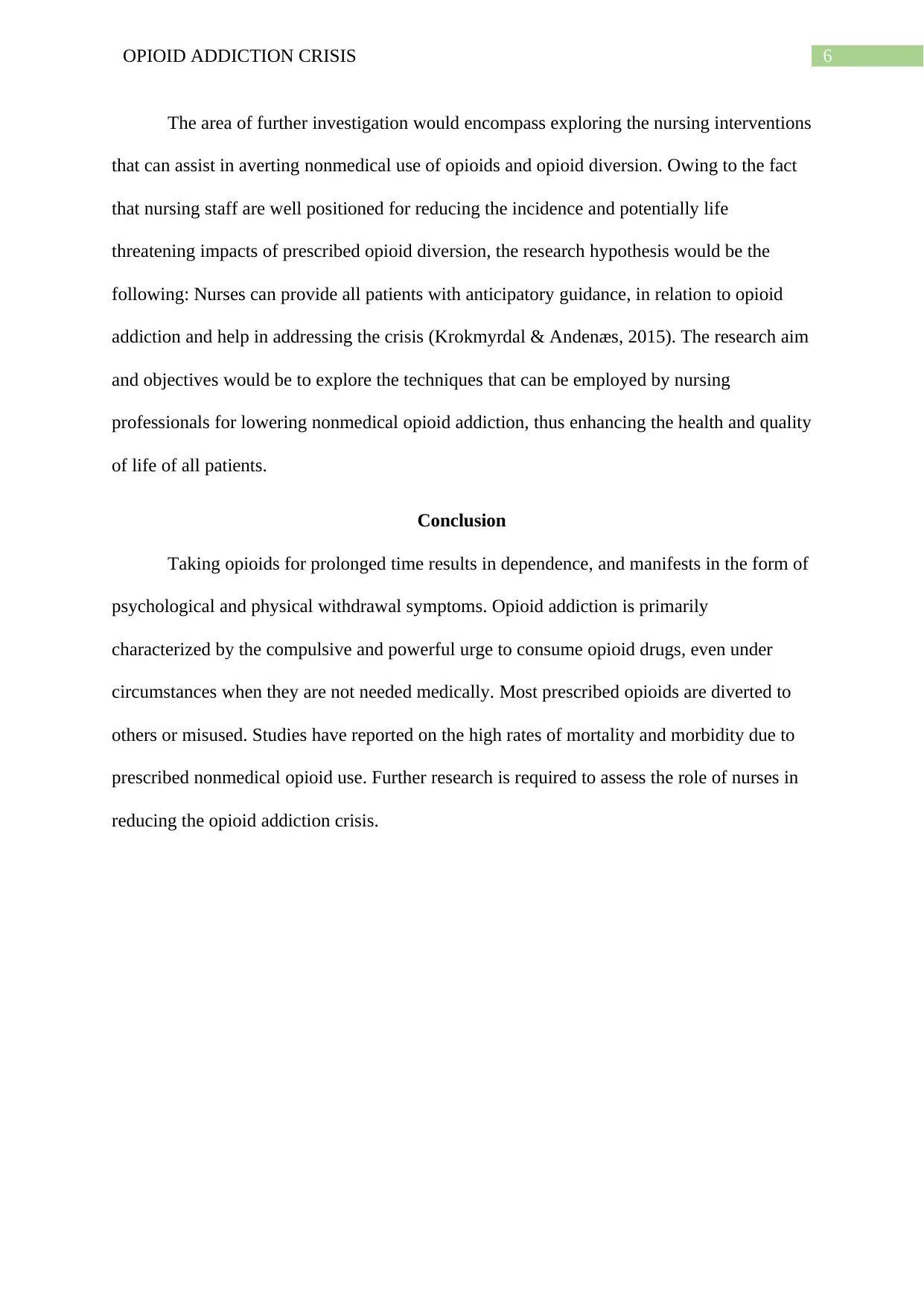
6OPIOID ADDICTION CRISIS
The area of further investigation would encompass exploring the nursing interventions
that can assist in averting nonmedical use of opioids and opioid diversion. Owing to the fact
that nursing staff are well positioned for reducing the incidence and potentially life
threatening impacts of prescribed opioid diversion, the research hypothesis would be the
following: Nurses can provide all patients with anticipatory guidance, in relation to opioid
addiction and help in addressing the crisis (Krokmyrdal & Andenæs, 2015). The research aim
and objectives would be to explore the techniques that can be employed by nursing
professionals for lowering nonmedical opioid addiction, thus enhancing the health and quality
of life of all patients.
Conclusion
Taking opioids for prolonged time results in dependence, and manifests in the form of
psychological and physical withdrawal symptoms. Opioid addiction is primarily
characterized by the compulsive and powerful urge to consume opioid drugs, even under
circumstances when they are not needed medically. Most prescribed opioids are diverted to
others or misused. Studies have reported on the high rates of mortality and morbidity due to
prescribed nonmedical opioid use. Further research is required to assess the role of nurses in
reducing the opioid addiction crisis.
The area of further investigation would encompass exploring the nursing interventions
that can assist in averting nonmedical use of opioids and opioid diversion. Owing to the fact
that nursing staff are well positioned for reducing the incidence and potentially life
threatening impacts of prescribed opioid diversion, the research hypothesis would be the
following: Nurses can provide all patients with anticipatory guidance, in relation to opioid
addiction and help in addressing the crisis (Krokmyrdal & Andenæs, 2015). The research aim
and objectives would be to explore the techniques that can be employed by nursing
professionals for lowering nonmedical opioid addiction, thus enhancing the health and quality
of life of all patients.
Conclusion
Taking opioids for prolonged time results in dependence, and manifests in the form of
psychological and physical withdrawal symptoms. Opioid addiction is primarily
characterized by the compulsive and powerful urge to consume opioid drugs, even under
circumstances when they are not needed medically. Most prescribed opioids are diverted to
others or misused. Studies have reported on the high rates of mortality and morbidity due to
prescribed nonmedical opioid use. Further research is required to assess the role of nurses in
reducing the opioid addiction crisis.
Paraphrase This Document
Need a fresh take? Get an instant paraphrase of this document with our AI Paraphraser
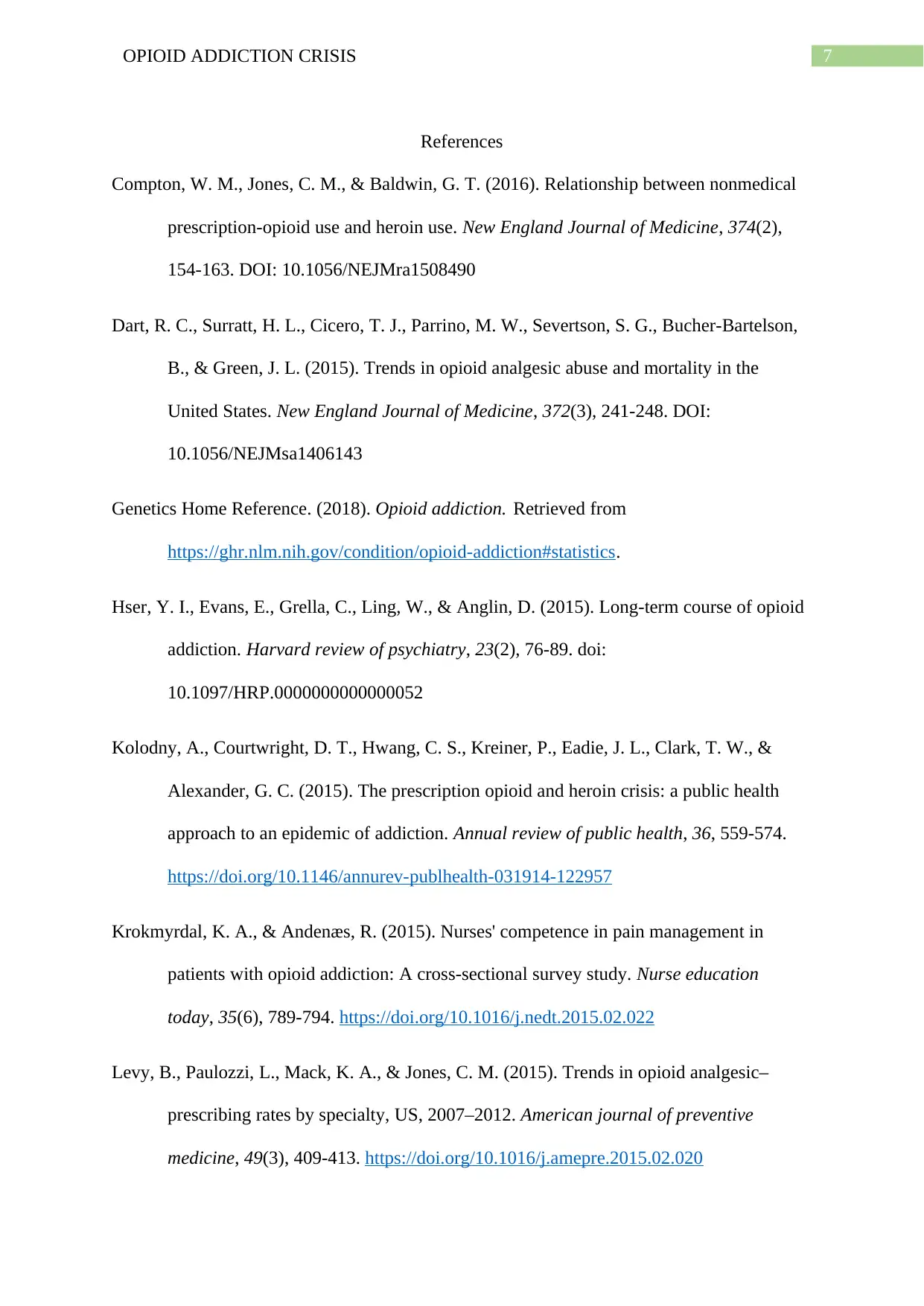
7OPIOID ADDICTION CRISIS
References
Compton, W. M., Jones, C. M., & Baldwin, G. T. (2016). Relationship between nonmedical
prescription-opioid use and heroin use. New England Journal of Medicine, 374(2),
154-163. DOI: 10.1056/NEJMra1508490
Dart, R. C., Surratt, H. L., Cicero, T. J., Parrino, M. W., Severtson, S. G., Bucher-Bartelson,
B., & Green, J. L. (2015). Trends in opioid analgesic abuse and mortality in the
United States. New England Journal of Medicine, 372(3), 241-248. DOI:
10.1056/NEJMsa1406143
Genetics Home Reference. (2018). Opioid addiction. Retrieved from
https://ghr.nlm.nih.gov/condition/opioid-addiction#statistics.
Hser, Y. I., Evans, E., Grella, C., Ling, W., & Anglin, D. (2015). Long-term course of opioid
addiction. Harvard review of psychiatry, 23(2), 76-89. doi:
10.1097/HRP.0000000000000052
Kolodny, A., Courtwright, D. T., Hwang, C. S., Kreiner, P., Eadie, J. L., Clark, T. W., &
Alexander, G. C. (2015). The prescription opioid and heroin crisis: a public health
approach to an epidemic of addiction. Annual review of public health, 36, 559-574.
https://doi.org/10.1146/annurev-publhealth-031914-122957
Krokmyrdal, K. A., & Andenæs, R. (2015). Nurses' competence in pain management in
patients with opioid addiction: A cross-sectional survey study. Nurse education
today, 35(6), 789-794. https://doi.org/10.1016/j.nedt.2015.02.022
Levy, B., Paulozzi, L., Mack, K. A., & Jones, C. M. (2015). Trends in opioid analgesic–
prescribing rates by specialty, US, 2007–2012. American journal of preventive
medicine, 49(3), 409-413. https://doi.org/10.1016/j.amepre.2015.02.020
References
Compton, W. M., Jones, C. M., & Baldwin, G. T. (2016). Relationship between nonmedical
prescription-opioid use and heroin use. New England Journal of Medicine, 374(2),
154-163. DOI: 10.1056/NEJMra1508490
Dart, R. C., Surratt, H. L., Cicero, T. J., Parrino, M. W., Severtson, S. G., Bucher-Bartelson,
B., & Green, J. L. (2015). Trends in opioid analgesic abuse and mortality in the
United States. New England Journal of Medicine, 372(3), 241-248. DOI:
10.1056/NEJMsa1406143
Genetics Home Reference. (2018). Opioid addiction. Retrieved from
https://ghr.nlm.nih.gov/condition/opioid-addiction#statistics.
Hser, Y. I., Evans, E., Grella, C., Ling, W., & Anglin, D. (2015). Long-term course of opioid
addiction. Harvard review of psychiatry, 23(2), 76-89. doi:
10.1097/HRP.0000000000000052
Kolodny, A., Courtwright, D. T., Hwang, C. S., Kreiner, P., Eadie, J. L., Clark, T. W., &
Alexander, G. C. (2015). The prescription opioid and heroin crisis: a public health
approach to an epidemic of addiction. Annual review of public health, 36, 559-574.
https://doi.org/10.1146/annurev-publhealth-031914-122957
Krokmyrdal, K. A., & Andenæs, R. (2015). Nurses' competence in pain management in
patients with opioid addiction: A cross-sectional survey study. Nurse education
today, 35(6), 789-794. https://doi.org/10.1016/j.nedt.2015.02.022
Levy, B., Paulozzi, L., Mack, K. A., & Jones, C. M. (2015). Trends in opioid analgesic–
prescribing rates by specialty, US, 2007–2012. American journal of preventive
medicine, 49(3), 409-413. https://doi.org/10.1016/j.amepre.2015.02.020
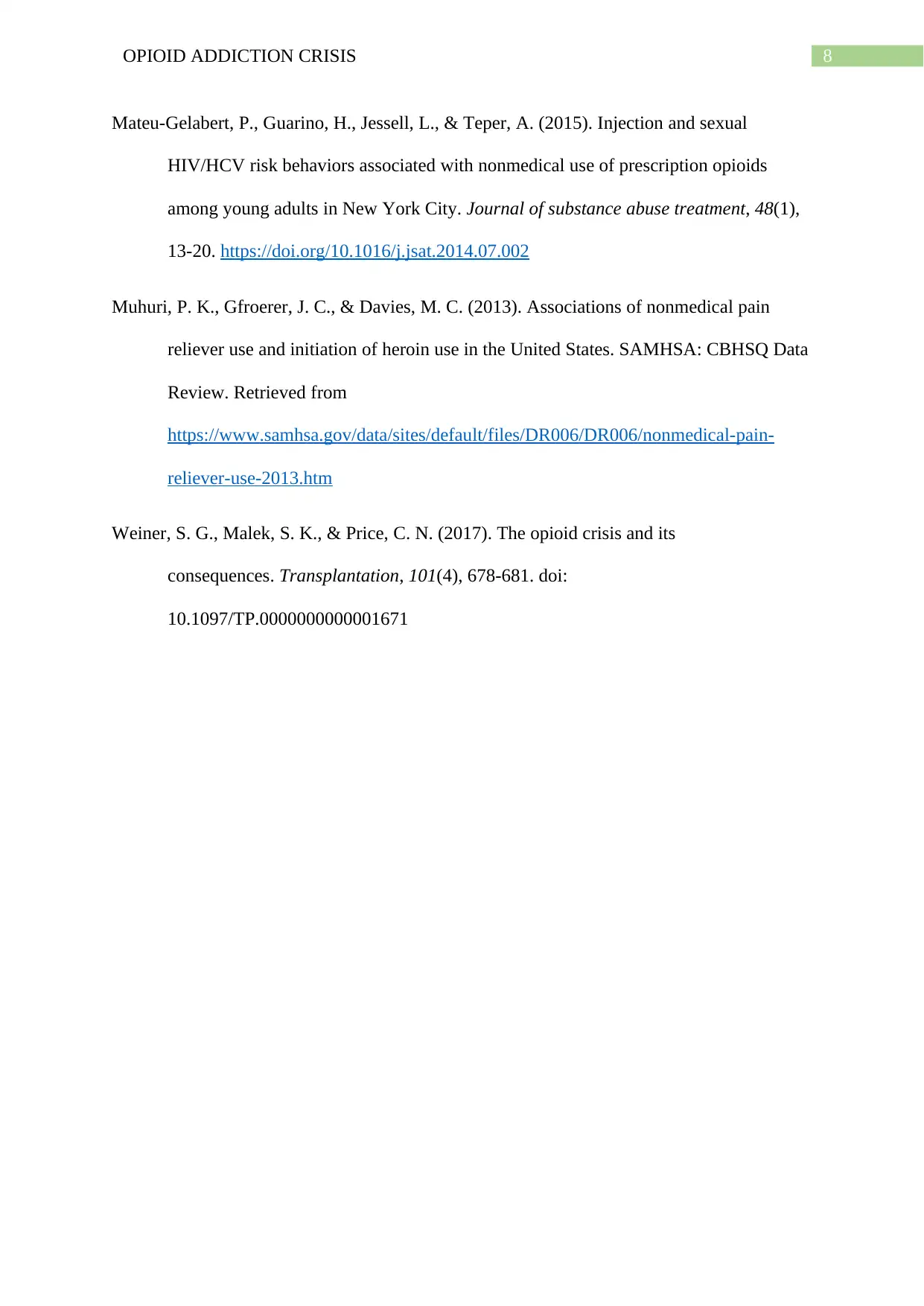
8OPIOID ADDICTION CRISIS
Mateu-Gelabert, P., Guarino, H., Jessell, L., & Teper, A. (2015). Injection and sexual
HIV/HCV risk behaviors associated with nonmedical use of prescription opioids
among young adults in New York City. Journal of substance abuse treatment, 48(1),
13-20. https://doi.org/10.1016/j.jsat.2014.07.002
Muhuri, P. K., Gfroerer, J. C., & Davies, M. C. (2013). Associations of nonmedical pain
reliever use and initiation of heroin use in the United States. SAMHSA: CBHSQ Data
Review. Retrieved from
https://www.samhsa.gov/data/sites/default/files/DR006/DR006/nonmedical-pain-
reliever-use-2013.htm
Weiner, S. G., Malek, S. K., & Price, C. N. (2017). The opioid crisis and its
consequences. Transplantation, 101(4), 678-681. doi:
10.1097/TP.0000000000001671
Mateu-Gelabert, P., Guarino, H., Jessell, L., & Teper, A. (2015). Injection and sexual
HIV/HCV risk behaviors associated with nonmedical use of prescription opioids
among young adults in New York City. Journal of substance abuse treatment, 48(1),
13-20. https://doi.org/10.1016/j.jsat.2014.07.002
Muhuri, P. K., Gfroerer, J. C., & Davies, M. C. (2013). Associations of nonmedical pain
reliever use and initiation of heroin use in the United States. SAMHSA: CBHSQ Data
Review. Retrieved from
https://www.samhsa.gov/data/sites/default/files/DR006/DR006/nonmedical-pain-
reliever-use-2013.htm
Weiner, S. G., Malek, S. K., & Price, C. N. (2017). The opioid crisis and its
consequences. Transplantation, 101(4), 678-681. doi:
10.1097/TP.0000000000001671
⊘ This is a preview!⊘
Do you want full access?
Subscribe today to unlock all pages.

Trusted by 1+ million students worldwide
1 out of 9
Related Documents
Your All-in-One AI-Powered Toolkit for Academic Success.
+13062052269
info@desklib.com
Available 24*7 on WhatsApp / Email
![[object Object]](/_next/static/media/star-bottom.7253800d.svg)
Unlock your academic potential
Copyright © 2020–2025 A2Z Services. All Rights Reserved. Developed and managed by ZUCOL.





